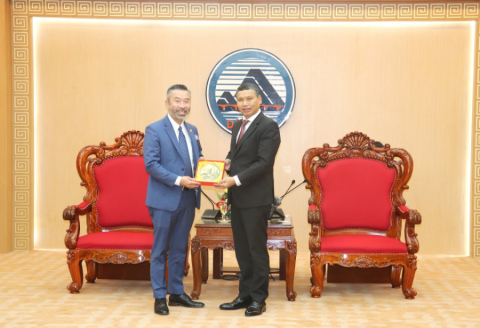A digital transformation framework for SMEs is demanded
- 100
- Digital
- 22:27 27/05/2022
DNHN - The current realities and barriers in the digital transformation process, according to Mr Nguyen Xuan Hoang, Vice Chairman of the SME Digital Transformation Committee, VINASA, demonstrate the need for a digital transformation framework for SMEs, assisting SMEs businesses step by step digital transformation, where to start, what to do, how the roadmap, and at the same time suitable to the size and type of each business.

Since 2018, Vietnam has been contemplating digital transformation. Until now, digital transformation has become a popular term, a hot topic raised in everything from high-level agendas to everyday stories of individuals and enterprises. Hundreds of thousands of SMEs, on the other hand, are grappling with digital transformation and are unsure where to begin. Meanwhile, SMEs constitute more than 98 per cent of all firms in Vietnam.
According to Ms Nguyen Ha Giang, Deputy Director of the Business Center, FSI Technology Development and Trade Investment Joint Stock Company, if SMEs want to succeed in digital transformation, they must begin transforming from the top. Business executives must agree on and commit to digital transformation while also developing an overarching plan.
Following that, it is vital to establish and implement goals and roadmaps for each step. Finally, firms must create an entire data warehouse and employ 4.0 technologies such as AI, Blockchain, and Cloud to develop new products and business models.
Mr Dang Duy Khanh, Director of Digital Transformation for SMEs, VNPT Group, who has assisted hundreds of enterprises around the country with digital transformation, stated: "When it comes to digital transformation, digital leadership is the first component. We think that digital transformation is more about business than it is about technology. Customers, workers, operations, and products are four important pillars that revolve around leadership, which is at the core of the digital transformation process. VNPT also creates a digital transformation framework for SMEs."
The realities and challenges in the digital transformation process, according to Mr Nguyen Xuan Hoang, demonstrate the need for a digital transformation framework for SMEs to aid firms step by step in digital transformation, where to start, and how to accomplish it. what, the plan, and suited for the size and style of each organization Businesses must know how to find the correct solution and supplier in the market after identifying the digital transformation strategy and process.
VINASA has chosen 26 sectors to design a digital transformation framework that is most suited for Vietnam's SMEs by combining experience, present circumstances, growth patterns of each industry, and references to reference models.
Each field's digital transformation framework is made up of five essential components. Part 1 is about the existing status and the path of development. Provide an overview of the present state, models, and types of enterprises in each sector, as well as future development patterns in that industry.
Part 2 is a digital transformation guide, and it is the most significant part, with a set of specialized solutions that are only required by organizations and businesses in the production and commercial domains. This solution set is separated into three tiers. These are the three stages of digital transformation for a business: preparation, development, and breakthrough.
Essential operations such as business/sales, production, and customer support all employ digital platforms and solutions at the readiness level. Development level targeted toward digital transformation for productivity-boosting automation. The breakthrough level analyzes business projections using data, big data, and AI, therefore uncovering new markets and producing new goods and services to assist organizations in developing breakthroughs.
Part three of the digital transformation framework is the package of solutions. This is the distinction in VINASA's guiding documents: for each tool, SMEs require in digital transformation stages, VINASA has established a set of associated solutions.
Part 4 includes training ideas for digital skills. People will determine whether or not digital transformation is successful. As a result, all VINASA guidelines propose that executives and staff be taught digital capabilities. Personnel is categorised based on system needs and qualities that require training.
Part 5 is a collection of evaluation criteria that SMEs may use to self-assess their level of digital transformation.
Mr Nguyen Xuan Hoang highlighted: "We believe that by using this digital transformation framework, SMEs will know where to begin, self-assess their digital transformation condition, and select products, solutions, and providers. level to meet demands, assisting businesses in transforming digitally as quickly as possible ".
Hai Anh
Related news
- CICON expands strategic alliances: A new step forward in Vietnam–Korea business connectivity
- What must Vietnamese enterprises do to maintain their position in the global supply chain?
- Vietnam advances cybersecurity law to boost digital sovereignty and business resilience
- Vietnam embraces digital tools to modernize public administration
- Administrative procedures for establishing the national technology exchange reduced to one application set
- Vietnam hits highest FDI inflow since 2009, fuels industrial real estate boom
- Foreign investors expected to open 150,000 new securities accounts in the next 5 years
- Government’s plan to implement Law on Digital Technology Industry approved
- Vietnam launches “Private Economy Panorama Model” to foster public-private national development
- Shark Nguyễn Hòa Bình: Hanoi will become the capital of startup innovation.
- Deputy Prime Minister Lê Thành Long meets with Osaka Governor Yoshimura Hirofumi to promote Vietnam–Japan cooperation.
- The master sales secrets of luxury king Bernard Arnault that make the world spend
- White House: When politics and technology join forces to rewrite the global AI order
- Da Nang proposes semiconductor cooperation with Oregon (USA)
- Quang Tri calls for investment in wind power plant project worth over VND 1,100 billion
- Hanoi receives two million visitors during the four-day National Day holidays
- Multiple MoUs signed in Da Nang to boost semiconductor development
- UNDP Resident Representative hails Vietnam as an emerging economic powerhouse
- How the UAE Transformed from Oil Wealth to AI Leadership?
- Success in business is always a human story
Đọc thêm Digital
Vietnam advances cybersecurity law to boost digital sovereignty and business resilience
In a significant step towards strengthening Vietnam’s digital defenses, the National Assembly Standing Committee convened on September 23 to review the draft revised Cybersecurity Law.
Vietnam embraces digital tools to modernize public administration
Across Vietnam, local governments are turning to digital platforms, QR codes, and AI-powered assistants to modernize public services—making them faster, more transparent, and more accessible to citizens.
Administrative procedures for establishing the national technology exchange reduced to one application set
Deputy Prime Minister Nguyen Hoa Binh has just signed Decision No. 2108/QD-TTg approving the plan to streamline internal administrative procedures within the state administrative system under the management of the Ministry of Science and Technology.
Government’s plan to implement Law on Digital Technology Industry approved
The Government has approved a plan to implement the Law on Digital Technology Industry (the Law) scheduled to take effect from January 1, 2026, according to a report from the Government News.
Shark Nguyễn Hòa Bình: Hanoi will become the capital of startup innovation.
Recently, in Hanoi, the seminar “Formulating City People’s Council Resolutions to Promote Science and Technology Development in Connection with the Implementation of Politburo Resolution No. 57-NQ/TW and the Capital Law No. 39/2024/QH15” was held.
Da Nang proposes semiconductor cooperation with Oregon (USA)
Leaders of Da Nang City have proposed that Oregon (USA) and the city explore cooperation opportunities in priority sectors such as semiconductor technology, logistics, and the development of Free Trade Zone (FTZ) infrastructure.
How the UAE Transformed from Oil Wealth to AI Leadership?
Once famed as the Gulf’s “oil brain,” the United Arab Emirates (UAE) is now redefining its global standing, emerging as one of the top three nations in artificial intelligence (AI), trailing only behind the United States.
ShopeeFood and Grab dominate Vietnam’s food delivery market
As 2025 begins, Vietnam’s food delivery market is expected to remain highly concentrated, with only a few platforms dominating the space unless new players enter the fray.
E-commerce in 2025: Explosive opportunities amid fierce competition
E-commerce in Vietnam continues to grow rapidly but faces intense competition and rising costs, forcing businesses to optimize strategies and technologies to maintain profitability.
The potential of the blockchain and cryptocurrency
Globally, the cryptocurrency market has seen significant growth. In Vietnam, despite not being officially recognized, cryptocurrencies like Bitcoin, Ethereum, Litecoin, and Ripple have emerged and are actively traded.











